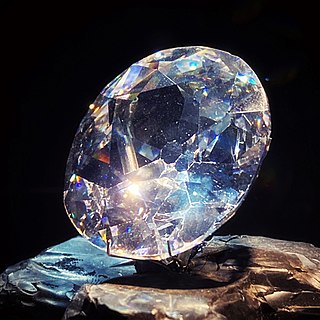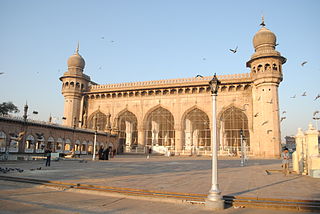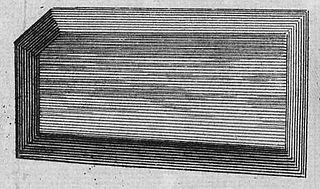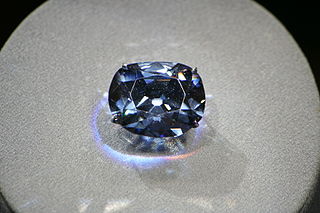
The Koh-i-Noor, also spelled Koh-e-Noor,Kohinoor and Koh-i-Nur, is one of the largest cut diamonds in the world, weighing 105.6 carats (21.12 g). It is part of the Crown Jewels of the United Kingdom. The diamond is currently set in the Crown of Queen Elizabeth The Queen Mother.

The Peacock Throne was a famous jewelled throne that was the seat of the emperors of the Mughal Empire in India. It was commissioned in the early 17th century by Emperor Shah Jahan and was located in the Diwan-i-Khas in the Red Fort of Delhi. It was named after a peacock as two peacocks are shown dancing at its rear.

Jean-Baptiste Tavernier (1605–1689) was a 17th-century French gem merchant and traveler. Tavernier, a private individual and merchant traveling at his own expense, covered, by his own account, 60,000 leagues in making six voyages to Persia and India between the years 1630 and 1668. In 1675, Tavernier, at the behest of his patron Louis XIV, published Les Six Voyages de Jean-Baptiste Tavernier.
Panna is a city and a municipality in Panna district in the Indian state of Madhya Pradesh. It is famous for its diamond mines and temples. It is the administrative center of Panna District.

Golconda is a fortified citadel and ruined city located in the western outskirts of Hyderabad, Telangana, India. The fort was originally built by Kakatiya ruler Pratāparudra in the 11th century out of mud walls. It was ceded to the Bahmani Kings from Musunuri Nayakas during the reign of the Bahmani Sultan Mohammed Shah I, during the first Bahmani-Vijayanagar War. Following the death of Sultan Mahmood Shah, the Sultanate disintegrated and Sultan Quli, who had been appointed as the Governor of Hyderabad by the Bahmani Kings, fortified city and made it the capital of the Golconda Sultanate. Because of the vicinity of diamond mines, especially Kollur Mine, Golconda flourished as a trade centre of large diamonds known as Golconda Diamonds. Golconda fort is currently abandoned and in ruins. The complex was put by UNESCO on its "tentative list" to become a World Heritage Site in 2014, with others in the region, under the name Monuments and Forts of the Deccan Sultanate.

Makkah Masjid or Mecca Masjid, is a congregational mosque in Hyderabad, India. It is the largest mosque in the city, and one of the largest mosques in the country, with a capacity of 10,000 people. The mosque was built during the 17th century, and is a state-protected monument. It serves as the primary mosque for the Old City of Hyderabad, and is located close to the historic landmarks of Charminar, Chowmahalla Palace and Laad Bazaar.

The Daria-i-Noor, also spelled Darya-ye Noor, is one of the largest cut diamonds in the world, weighing an estimated 182 carats. Its colour, pale pink, is one of the rarest to be found in diamonds. The diamond is currently in the Iranian National Jewels collection of the Central Bank of Iran in Tehran. However, another theory posits that it is currently in a private collection within Bangladesh.
The Nizam Diamond, also known as the "little Koh-i-noor", was a famous diamond in the 1800s. Its whereabouts today are unknown. It was named after its original owner Mir Osman Ali Khan, the last Nizam of Hyderabad. The diamond is said to have been around 340 carats (68 g) in size, and was mined from the now-submerged Kollur mine in the Krishna River valley in the year 1830.
Karwan is one of the major suburbs in Hyderabad, Telangana, India. It is a part of the old city of Hyderabad.
Paritala is a village in the NTR district of the state of Andhra Pradesh, South India. It is located in Kanchikacherla mandal of Vijayawada revenue division.

Mir Jumla II, also known as Ardistānī Mir Muhammad, was a wealthy diamond trader, a Vizier of Golconda sultanate, and later a prominent subahdar of Bengal under the Mughal Emperor Aurangzeb.

The Diamond Queen is a 1953 American adventure film directed by John Brahm. It stars Fernando Lamas and Arlene Dahl.

The Great Mogul was a large diamond that is believed to have been discovered around 1650, most probably around the Kollur Mine in the Golconda region of southern India. Tavernier described the diamond thus: "The stone is of the same form as if one cut an egg through the middle".

The Great Table was a large pink diamond that had been studded in the throne of the Mughal emperor Shah Jahan. It has been described in the book of the French jeweller Jean-Baptiste Tavernier in 1642, who gave it its name.

Golconda diamonds are mined in the Godavari delta region of the present-day states Andhra Pradesh and Telangana, India. Golconda Fort in the western part of modern-day Hyderabad was a seat of the Golconda Sultanate and became an important centre for diamond enhancement, lapidary, and trading. Golconda diamonds are graded as Type IIa, are formed of pure carbon, are devoid of nitrogen, and are large with high clarity. They are often described as diamonds of the first water, making them among history's most-celebrated diamonds. The phrase "Golconda diamond" became synonymous with diamonds of incomparable quality.

Blue diamond is a type of diamond which exhibits all of the same inherent properties of the mineral except with the additional element of blue color in the stone. They are colored blue by trace amounts of boron that contaminate the crystalline lattice structure. Blue diamonds belong to a subcategory of diamonds called fancy color diamonds, the generic name for diamonds that exhibit intense color.

Pink diamond is a type of diamond that has pink color. The source of their pink color is greatly debated in the gemological world but it is most commonly attributed to plastic deformation that these diamonds undergo during their formation.
Diamond mining in India extends back into antiquity. From ancient times, India was the source of nearly all the world's known diamonds, and until the discovery of diamonds in South Africa in 1896, India was the only place where diamonds were mined. India has not been a major diamond-producing country since the 1900s, but diamond mining continues. In 2013, India mined 37,515 carats of diamonds, from one industrial-scale mine and many artisanal mines; this was less than one-tenth of one percent of the world production of 132.9 million carats.
The Shah Jahan Diamond mined from Kollur, Golconda—(currently Hyderabad, India). It is a hololithic flat, table cut 56 carat diamond, used as an amulet—(Tawid'th). In late 1600 AD Mughal Emperor Jahangir gifted it to Prince Shah Jahan—(by his name it is known). Currently it is owned by Dar al Athar al Islamiyyah, Kuwait.

The period of peak production of the Golconda diamonds was under the Qutb Shahi dynasty, and the region was also known as the "Golconda Sultanate". The Asaf Jahi dynasty was later dominant, and it was also known as the "Nizam of Hyderabad". During these times, the diamond mines were leased out to merchants under the supervision of regional governors. The periods of the leases were recorded in days. Local merchants Shantidas Jhaveri and Khushalchand were legendary diamond traders of the region. Large diamonds obtained from the mines were reserved for the rulers under terms of the leases.

















